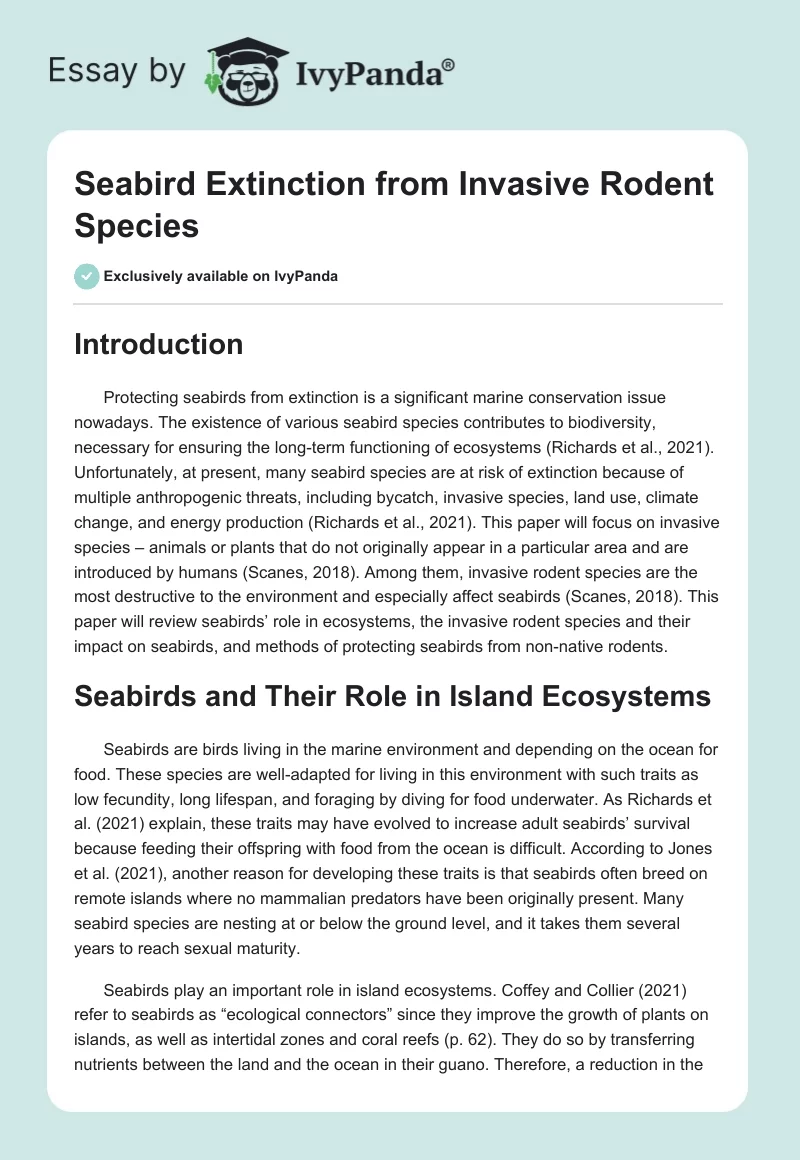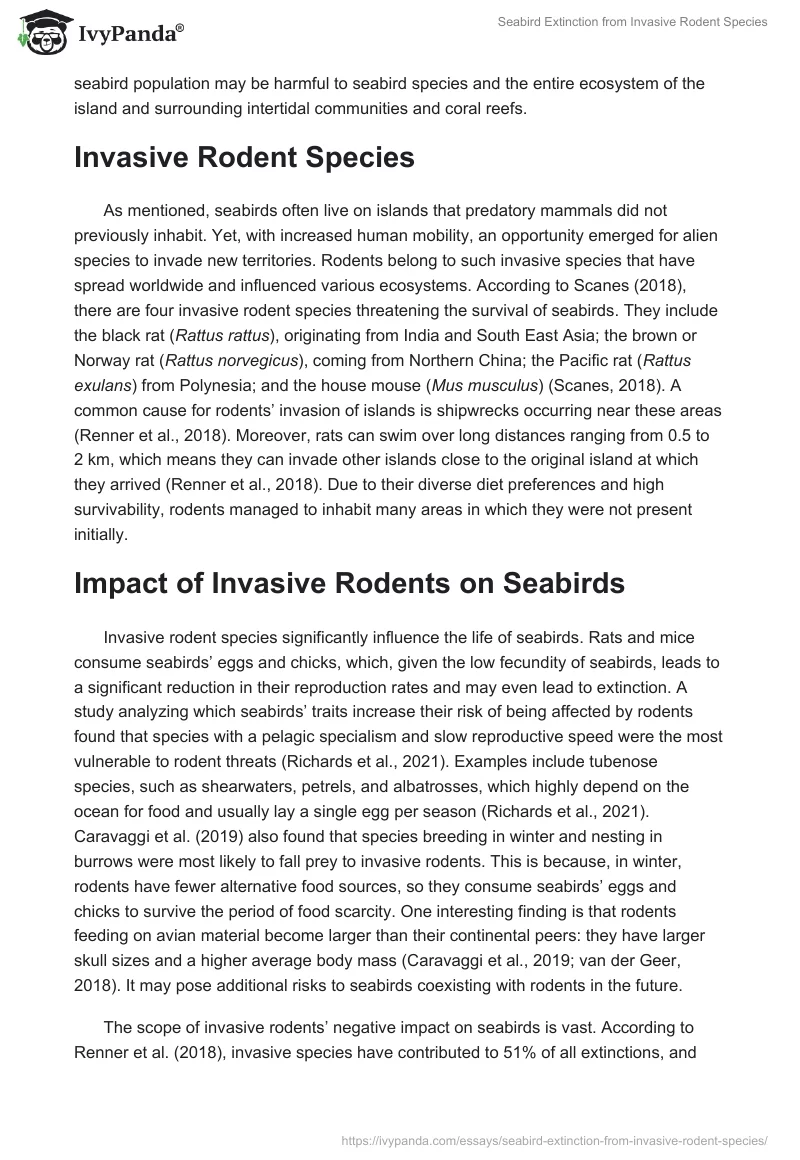Introduction
Protecting seabirds from extinction is a significant marine conservation issue nowadays. The existence of various seabird species contributes to biodiversity, necessary for ensuring the long-term functioning of ecosystems (Richards et al., 2021). Unfortunately, at present, many seabird species are at risk of extinction because of multiple anthropogenic threats, including bycatch, invasive species, land use, climate change, and energy production (Richards et al., 2021). This paper will focus on invasive species – animals or plants that do not originally appear in a particular area and are introduced by humans (Scanes, 2018). Among them, invasive rodent species are the most destructive to the environment and especially affect seabirds (Scanes, 2018). This paper will review seabirds’ role in ecosystems, the invasive rodent species and their impact on seabirds, and methods of protecting seabirds from non-native rodents.
Seabirds and Their Role in Island Ecosystems
Seabirds are birds living in the marine environment and depending on the ocean for food. These species are well-adapted for living in this environment with such traits as low fecundity, long lifespan, and foraging by diving for food underwater. As Richards et al. (2021) explain, these traits may have evolved to increase adult seabirds’ survival because feeding their offspring with food from the ocean is difficult. According to Jones et al. (2021), another reason for developing these traits is that seabirds often breed on remote islands where no mammalian predators have been originally present. Many seabird species are nesting at or below the ground level, and it takes them several years to reach sexual maturity.
Seabirds play an important role in island ecosystems. Coffey and Collier (2021) refer to seabirds as “ecological connectors” since they improve the growth of plants on islands, as well as intertidal zones and coral reefs (p. 62). They do so by transferring nutrients between the land and the ocean in their guano. Therefore, a reduction in the seabird population may be harmful to seabird species and the entire ecosystem of the island and surrounding intertidal communities and coral reefs.
Invasive Rodent Species
As mentioned, seabirds often live on islands that predatory mammals did not previously inhabit. Yet, with increased human mobility, an opportunity emerged for alien species to invade new territories. Rodents belong to such invasive species that have spread worldwide and influenced various ecosystems. According to Scanes (2018), there are four invasive rodent species threatening the survival of seabirds. They include the black rat (Rattus rattus), originating from India and South East Asia; the brown or Norway rat (Rattus norvegicus), coming from Northern China; the Pacific rat (Rattus exulans) from Polynesia; and the house mouse (Mus musculus) (Scanes, 2018). A common cause for rodents’ invasion of islands is shipwrecks occurring near these areas (Renner et al., 2018). Moreover, rats can swim over long distances ranging from 0.5 to 2 km, which means they can invade other islands close to the original island at which they arrived (Renner et al., 2018). Due to their diverse diet preferences and high survivability, rodents managed to inhabit many areas in which they were not present initially.
Impact of Invasive Rodents on Seabirds
Invasive rodent species significantly influence the life of seabirds. Rats and mice consume seabirds’ eggs and chicks, which, given the low fecundity of seabirds, leads to a significant reduction in their reproduction rates and may even lead to extinction. A study analyzing which seabirds’ traits increase their risk of being affected by rodents found that species with a pelagic specialism and slow reproductive speed were the most vulnerable to rodent threats (Richards et al., 2021). Examples include tubenose species, such as shearwaters, petrels, and albatrosses, which highly depend on the ocean for food and usually lay a single egg per season (Richards et al., 2021). Caravaggi et al. (2019) also found that species breeding in winter and nesting in burrows were most likely to fall prey to invasive rodents. This is because, in winter, rodents have fewer alternative food sources, so they consume seabirds’ eggs and chicks to survive the period of food scarcity. One interesting finding is that rodents feeding on avian material become larger than their continental peers: they have larger skull sizes and a higher average body mass (Caravaggi et al., 2019; van der Geer, 2018). It may pose additional risks to seabirds coexisting with rodents in the future.
The scope of invasive rodents’ negative impact on seabirds is vast. According to Renner et al. (2018), invasive species have contributed to 51% of all extinctions, and among these species, rats caused the highest number of seabird extinctions than any other non-native species. Invasive rodents undermine the breeding success of many seabirds. For example, on Gough Island, it is estimated that only 33% of seabird pairs succeed in raising their chicks to fledging due to nest depredation by mice (Caravaggi et al., 2019). Moreover, MacGillivray’s prion, a small-sized seabird species nearly endemic to Gough Island, can become extinct by 2057 with a 31% probability because of mouse predation (Jones et al., 2021). Rodent species also pose a significant threat to the survival of endemic seabird species – Vireo gracilirostris and Elaenia ridleyana – on Fernando de Noronha (Micheletti et al., 2020). This evidence suggests that, without effective interventions, seabirds are at an increased risk of extinction due to invasive rodent species’ predation.
Ways of Protecting Seabirds from Invasive Rodent Species
Previously, eradicating rodents from islands was considered an impossible task. However, nowadays, not only is this viewed as possible, but there are also examples of successful eradication. For instance, in 2017, the rodent species R. rattus was eradicated from the Meio island, which is part of the Fernando de Noronha archipelago (Micheletti et al., 2020). This led to an increase in the breeding population of Sula leucogaster and E. ridleyana three months later (Micheletti et al., 2020). On Saint-Paul Island, situated in the south of the Indian Ocean, rat eradication resulted in increased seabird population growth rates 20 years later, especially in species most vulnerable to rodent depredation (Barbraud et al., 2021). Yet, even if eradicating one rodent species appears to be successful, it may not always positively affect seabird populations. For instance, on the Island of Rum, Scotland, rat eradication led to an increased activity of mice, which neutralized the positive effects of the operation (Lambert et al., 2021). Nevertheless, evidence shows that rodent eradication campaigns can be an effective method of preserving seabird species.
Yet, rat and mouse eradication may turn out to be useless if no preventive measures are taken to avoid rodents’ reinvasion of islands. For example, although the largest rodent eradication campaign conducted on the island of South Georgia cleaned the area from rodents, 3.5 years later, new tracks of rats were noticed on the snow shortly after two ships moored nearby (Martin & Richardson, 2019). To detect whether the rodent species remained after unsuccessful eradication or reinvaded, researchers may use various genetic and genomic instruments (Sjodin et al., 2020). The possibility of reinvasion points to the need for preventive measures and public education.
Conclusion
To sum up, by traveling by ships, humans introduced invasive rodent species to islands serving as the habitat for many seabird species. Non-native rodents present a significant threat of seabird extinction, undermining seabirds’ breeding success by eating their eggs and chicks. Rodent eradication campaigns appear effective for clearing islands from rodents, but they are expensive, and preventive measures are needed to protect the areas from reinvasion.
References
Barbraud, C., Delord, K., Le Bouard, F., Harivel, R., Demay, J., Chaigne, A., & Micol, T. (2021). Seabird population changes following mammal eradication at oceanic Saint-Paul Island, Indian Ocean. Journal for Nature Conservation, 63(126049), 1-9.
Caravaggi, A., Cuthbert, R. J., Ryan, P. G., Cooper, J., & Bond, A. L. (2019). The impacts of introduced House Mice on the breeding success of nesting seabirds on Gough Island. Ibis: The International Journal of Avian Science, 161(3), 648-661.
Coffey, J., & Collier, N. (2021). Introduced mammals threaten the Grenadines transboundary tropical seabird hotspot. Journal of Caribbean Ornithology, 34, 61-74.
Jones, C. W., Risi, M. M., Osborne, A. M., Ryan, P. G., & Oppel, S. (2021). Mouse eradication is required to prevent local extinction of an endangered seabird on an oceanic island. Animal Conservation, 24(4), 637-645.
Lambert, M., Carlisle, S., Cain, I., Douse, A., & Watt, L. (2021). Unexpected involvement of a second rodent species makes impacts of introduced rats more difficult to detect. Scientific Reports, 11(1), 1-10.
Martin, A., & Richardson, M. (2019). Rodent eradication scaled up: Clearing rats and mice from South Georgia. Oryx, 53(1), 27-35.
Micheletti, T., Fonseca, F. S., Mangini, P. R., Serafini, P. P., Krul, R., Mello, T. J., Freitas, M. G., Dias, R. A., Silva, J. C. R., Marvulo, M. F. V., Araujo, R., Gasparotto, V. P. O., Abrahão, C. R., Rebouças, R., Toledo, L. F., Siqueira, P. G. S. C., Duarte, H. O., Moura, M. J. C., Fernandes-Santos, R. C., & Russell, J. C. (2020). Terrestrial invasive species on Fernando de Noronha archipelago: What we know and the way forward. In V. Londe (Ed.), Invasive species: Ecology, impacts, and potential uses (pp. 51-94). Nova Science Publishers.
Renner, M., Nelson, E., Watson, J., Haynie, A., Poe, A., Robards, M., & Hess, S. C. (2018). The risk of rodent introductions from shipwrecks to seabirds on Aleutian and Bering Sea islands. Biological Invasions, 20(9), 2679-2690.
Richards, C., Cooke, R. S., & Bates, A. E. (2021). Biological traits of seabirds predict extinction risk and vulnerability to anthropogenic threats. Global Ecology and Biogeography, 30(5), 973-986.
Scanes, C. G. (2018). Invasive species. In C. G. Scanes & S. R. Toukhsati (Eds.), Animals and human society (pp. 413-426). Academic Press.
Sjodin, B. M., Irvine, R. L., & Russello, M. A. (2020). RapidRat: Development, validation and application of a genotyping-by-sequencing panel for rapid biosecurity and invasive species management. PloS One, 15(6), e0234694.
van der Geer, A. A. (2018). Changing invaders: Trends of gigantism in insular introduced rats. Environmental Conservation, 45(3), 203-211.


